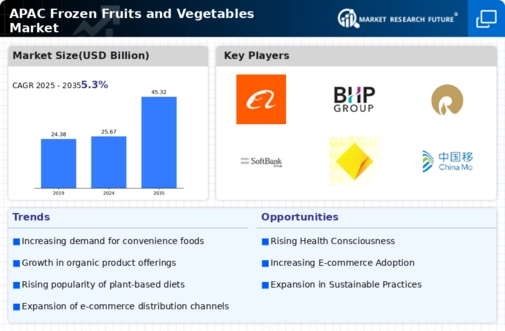Top Industry Leaders in the APAC Frozen Fruits Vegetables Market
The APAC Frozen Fruits and Vegetables Market is a thriving segment within the global frozen food industry, shaped by the diverse preferences and dietary habits of consumers across the Asia-Pacific region. Examining the competitive landscape involves scrutinizing key players, their strategies, market share determinants, emerging entities, industry dynamics, investment trends, and recent developments in 2023.
Key Players:
Dole (U.S.)
Ardo NV (Belgium)
HJ Heinz (US)
Simplot Australia PTY Ltd (Australia)
General Mills (U.S.)
Findus Sverige AB
(Sweden)
Pinnacle Foods Corp. (US)
and Bonduelle Group (France)
Nanjing Zhongliang Organic Fruits and Vegetables Food Co.
Ltd. (China)
Allanasons Private Limited (India).
Strategies Adopted:
Key players in the APAC Frozen Fruits and Vegetables Market deploy various strategies to gain and sustain a competitive edge. Continuous product innovation is a primary focus, with companies investing in research and development to introduce new frozen fruit and vegetable variants that align with local preferences. Strategic partnerships with retailers and distributors enable efficient market penetration, ensuring a robust supply chain and widespread availability. Moreover, investments in state-of-the-art freezing technologies and sustainable sourcing practices are common strategies to enhance product quality and appeal to environmentally conscious consumers.
Market Share Analysis:
Determining market share in the APAC Frozen Fruits and Vegetables Market involves considering multiple factors. The ability to offer a diverse range of high-quality frozen products, including exotic fruits and locally popular vegetables, is crucial. Strong distribution networks that span urban and rural areas contribute to market dominance, ensuring accessibility to a broad consumer base. Additionally, efficient cold chain logistics, compliance with food safety regulations, and competitive pricing play pivotal roles in securing and expanding market share.
New and Emerging Companies:
The APAC region witnesses the emergence of new and agile companies seeking to tap into the growing demand for frozen fruits and vegetables. Local startups like Fresh Harvest and GreenLife are making strides by focusing on organic and locally sourced frozen produce, catering to the health-conscious segment. These companies often leverage e-commerce platforms and digital marketing to establish a direct connection with consumers, capitalizing on the increasing trend of online grocery shopping in the region.
Industry Trends:
In 2023, industry news and investment trends within the APAC Frozen Fruits and Vegetables Market revolve around sustainability, technological advancements, and strategic expansions. Key players are increasingly investing in sustainable and eco-friendly packaging solutions to address environmental concerns and align with consumer values. Furthermore, investments in automation and artificial intelligence technologies for processing and packaging operations enhance efficiency and reduce production costs. Strategic expansions involve companies entering new markets within the APAC region or forming collaborations with local farmers and suppliers to strengthen their regional supply chains.
Competitive Scenario:
The overall competitive scenario in the APAC Frozen Fruits and Vegetables Market reflects a balance between established multinational players and nimble local entities. Established companies leverage their global expertise, brand recognition, and extensive distribution networks, while emerging players capitalize on regional insights, agility, and a focus on specialized product offerings.
Recent Development
A significant development in 2023 involves McCain Foods' announcement of a strategic investment in a state-of-the-art freezing facility in India. This move signifies the company's commitment to expanding its presence in the APAC region and meeting the increasing demand for high-quality frozen fruits and vegetables in India's burgeoning market. Such investments showcase the industry's dedication to infrastructure development and capacity enhancement to keep pace with growing consumer demands.


